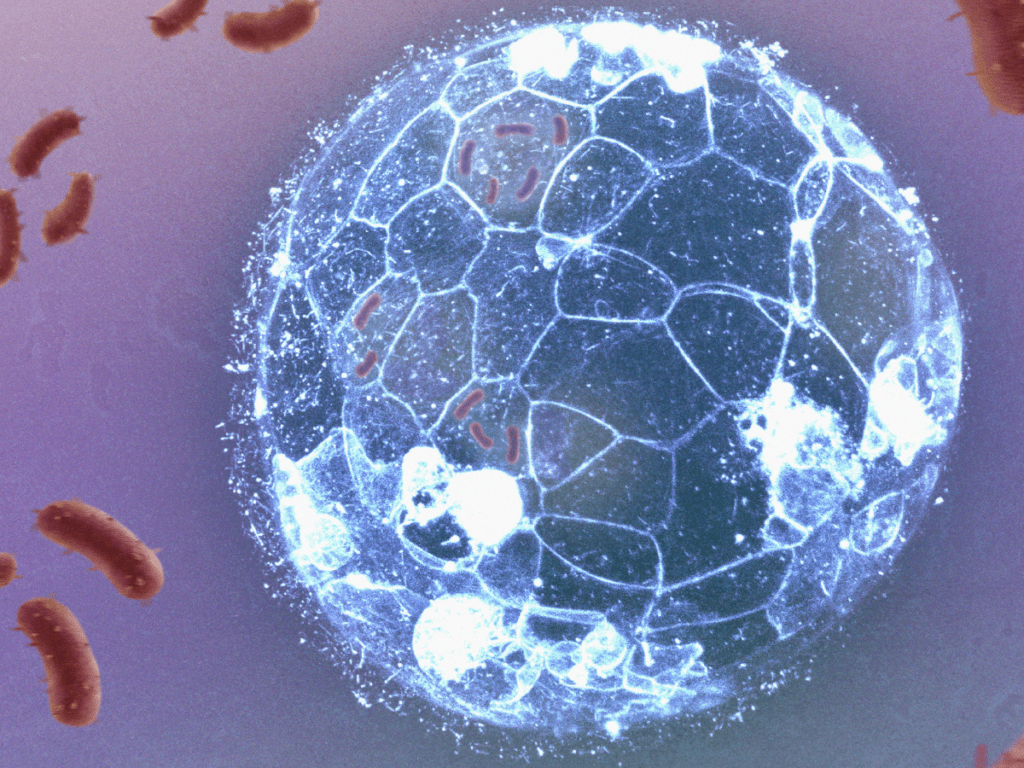The work, led by a team from the CSIC and IDIBELL, with the collaboration of IBEC, manages to visualise how embryonic cells eliminate bacterial infections, before the formation of the immune system. The research describes a mechanism of phagocytosis similar to that used by white blood cells, and reveals that this mechanism is also present in human embryos.

Research led by scientists from the Institute of Molecular Biology of Barcelona (IBMB) of the CSIC and the Bellvitge Biomedical Research Institute (IDIBELL) withthe collaboration ofthe Institute for Bioengineering of Catalonia (IBEC), has managed to film how a few days-old embryos defend themselves from a potential infection by bacteria. The work is published this week in the journal Cell Host and Microbe.
Specifically, they have been able to see how zebrafish embryos use cells present on their surface, known as epithelial cells, to ingest and destroy bacteria through a process called phagocytosis, similar to that carried out by white blood cells. Crucially, scientists could observe that this ability to eliminate bacteria is also present in human embryos.
For the first time, we have discovered the ability of embryos to eliminate infections, which may be highly relevant in the field of reproductive medicine.
Eduard Torrents
Using state-of-the-art microscopy techniques, the research shows how cells capture Escherichia coli and Staphylococcus aureus bacteria through small protrusions of their membrane, in which the protein Actin is involved. “Our research shows that, at the beginning of development – before implantation in the uterus and before the formation of organs – embryos already have a defence system that allows them to eliminate bacterial infections,” says Esteban Hoijman, researcher at IBMB-CSIC and IDIBELL, leader of the research. The first author of the work is Joan Roncero-Carol, predoctoral researcher at the Embryonic Cell Bioimaging Laboratory of the CSIC-IDIBELL.
This process, scientist explain, works as a phagocytosis mechanism, activates immunity genes in these cells, effectively eliminates bacteria and contributes to the correct embryonic development in case of infection.
“This system could represent the origin of immunity. The study reveals the first interaction between the newly forming organism and its biological microenvironment,” adds Hoijman, who heads the Embryonic Cell Bioimaging laboratory.
Our lab prepared the samples for fluorescence microscopy, which enabled us to demonstrate that blastocyst cells can phagocytise external particles and bacteria.
Marc Casals
Regarding IBEC’s involvement in the study, Núria Blanco Cabra and Eduard Torrents, who are part of the institute’s Bacterial Infections and Antimicrobial Therapies (BIAT) group, participated in experiments investigating the interaction between embryos and pathogenic bacteria. “This work opens up a new avenue for understanding how the embryo can interact with bacteria as a protective mechanism. For the first time, we have discovered the ability of embryos to eliminate infections, which may be highly relevant in the field of reproductive medicine,” says Torrents, the group’s principal investigator and co-author of the study.
Meanwhile, the Bioengineering in Reproductive Health group at IBEC, led by Samuel Ojosnegros (co-author of the study), contributed to the research by culturing embryos for the experiments. “We were responsible for the hormone treatment and obtaining the embryos, as well as culturing them to the blastocyst stage. We also prepared the samples for fluorescence microscopy, which enabled us to demonstrate that blastocyst cells can phagocytise external particles and bacteria,” explains Marc Casals, a scientist in the group and co-author of the study.
The research also involved scientists from Centre for Genomic Regulation (CRG), Pompeu Fabra University (UPF), the University of Barcelona (UB), the Dexeus University Hospital and ICREA.
Preventing malformations and improving reproductive therapies
At the beginning of development, embryos are exposed to multiple changes in their environment which can pose a threat, since embryos have not yet developed the immune system to protect them.
This work could help us, in the future, to improve fertility, prevent embryonic malformations and develop new reproductive therapies.
Esteban Hoijman
In the uterus, infections have a high incidence and are associated with infertility. However, it has remained a mystery until now how an embryo reacts when it encounters a bacterium. This work reveals that immune capacities of an embryo begin long before the existence of white blood cells, and “could help us, in the future, to improve fertility, prevent embryonic malformations and develop new reproductive therapies,” explains Esteban Hoijman.
In this sense, the finding also highlights the important need to know in more detail the population of bacteria that can colonize the uterus, differentiating the invaders (and possible pathogens) from potential resident bacteria that could have beneficial effects on reproductive physiology.
Referenced paper:
Joan Roncero-Carol, June Olaizola-Muñoa, Begoña Arán, Loris Sebastiano Mularoni, Marta Miret Cuesta, Nuria Blanco-Cabra, Marc Casals, Mireia Rumbo, Miquel Sole Inarejos, Samuel Ojosnegros, Berta Alsina, Eduard Torrents, Anna Veiga, Manuel Irimia and Esteban Hoijman* Epithelial cells provide immunocompetence to the early embryo for bacterial clearance, Cell Host and Microbe (2025). DOI: 10.1016/j.chom.2025.05.025





